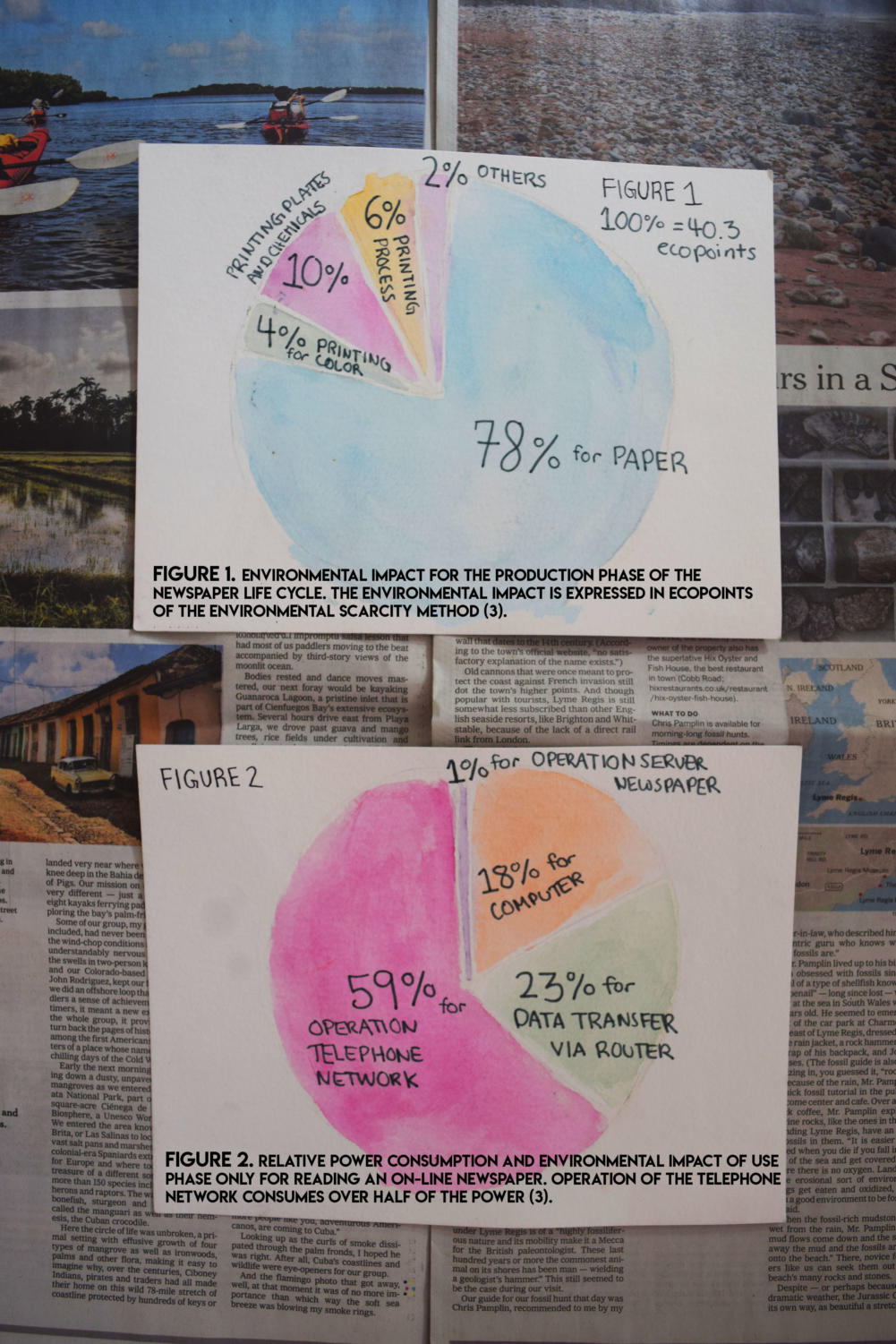Reassess Your FootPRINT
7 MIN READSince we were young, the concept of excess paper usage has been villainized at the turn of every page due to its notorious association with environmental degradation. In the Silicon Valley, with access to innumerable digital alternatives, having the New York Times delivered to your house each Sunday has been deemed unnecessarily wasteful by some. Besides those who hold their traditionally printed papers close to them, most of us have been willingly nudged towards a paperless ideal. Palo Alto High School– home to a nationally ranked journalism program, with eight printed publications– has taken into consideration this “save the trees” mantra. However, for the journalism industry, both print and online, the implications drawn surrounding the environmental impacts of each may need to be re-evaluated, particularly in the United States and even on our campus grounds.
Traditional print newspapers and magazines have been in undeniable decline in recent years. According to Pew Research Center, weekday distribution of newspapers in the U.S. decreased by 8 percent between 2015 and 2016 and digital readership for the top 50 major daily papers has increased by a steep 21 percent from 2015-20161. In respect to how this data affects total readership, The American Press Institute published a breakdown for 2018, showing that 58 percent of subscribers to a media source (newspaper or magazine) receive their subscription primarily print based, 28 percent primarily digitally based, and the remaining 14 percent use both equally2. These numbers reveal the consumer trend towards digital journalism, however, there is something to be said for the still-present value of print; the two formats rest in a balance that must account for both readership and the environmental costs of production .
Vivek Garg, of aPrintis, the publisher for Paly’s C Magazine, spoke to this topic: “[the printing industry] has been declining, but it hasn’t been declining at the rate that people thought it would, especially in some segments such as magazines.” For the producer, many magazines are becoming hybrids, with both print and digital versions– a feature of most Paly publications– whereas some producers have decided to fully abandon print, due to the expenses that come with it. Garg has observed that many magazines that have shifted completely digital in years past are resurfacing, realizing that “readership was actually very low because of the dizzying number of alternatives available online.” He believes print is often read when an individual decides that “[they] want to dedicate [themselves] and invest into this piece of content.” He identified that both the consumer and producer are reconsidering print, and determining when the printed format is sensible.
From an environmental perspective the sensibility of print news, particularly in comparison to digital news also needs to be identified,; the largest issue at hand is that there has been so little national effort to do so in the U.S. The life cycle analyses– a “cradle to grave” assessment of a product’s environmental impact– for each format have not been considered extensively enough as to conclude that one is superior to another.
One of the most comprehensive and current analyses of news consumption in the formats of both print, online and television broadcasts was done by MIT and Yale University professors on the typical readership of a Swiss-German citizen3. Two types of hybrid-style Swiss newspapers were chosen to follow, one a more “voluminous” professional paper, and the other more similar to a tabloid, identified a “thin” newspaper*.
Two systems of internationally recognized environmental assessment methods were used to follow the impacts of each of these papers and their corresponding websites: “environmental scarcity,” measured in ecopoints and the Eco Indicator 99, measured in milli-Eco Indicator points3. It was discovered that when accessing the unit of a singular news story from a newspaper, the ecopoints were significantly lower than accessing the same news item from its digital counterpart. This individual printed story accounted for .4 ecopoints, and the internet item accounted for roughly 2.6 ecopoints3. A second unit of measure was taken which was accessing the entirety of the daily news. It was found that both the print newspapers amounted to more ecopoints resting at around 59 for the voluminous newspaper and 37 for the thin newspaper, with the internet newspaper only amounting to around 17 ecopoints3. This data presents the environmental differences that come with the quantity of consumership on each platform. Additionally, when the Swiss energy mix was replaced with the average European electricity mix, the environmental impact of the internet newspapers was doubled, revealing the pressing issue of needing sustainable and low carbon emission fuel sources.3 (the data for each type of online newspaper in this aspect of the study were combined because their differences were found to be negligible). The raw energy breakdowns of the life cycle of each are displayed in figures 1 and 2. Figure 1 is measured in ecopoints, and displays the impacts of each step of the print newspaper life cycle, and figure 2 displays the energy consumption at each step of the digital newspaper life cycle. These breakdowns serve to identify what components play most deeply into environmental impact, and encourages investigation and innovation towards making them more sustainable.

The result of this international study, although not a direct analysis of American environmental impact through journalism, aids in revealing the complexity of the balance at hand: managing the readership trends and sustainability of print and online news. Certain American trends can be looked at to predict what pin the two platforms against each other, and what can be done to increase sustainability.
Online news platforms often provide the ability to search for one specific article immediately, and in this respect is more environmentally detrimental than reading the paper on the same topic would be. This is likely an applicable issue for American readers as the average time spent on internet news sites is roughly 2.45 minutes per opening the site1, which according to Execuread would account for around 600 words4, likely only one article. Although the readers of individual articles may pose an environmental issue, readers of the daily news can contribute to a better environment if the energy mixes used to power the life cycle are responsibly sourced. The search for sustainable energy options in the United States is one that exists, but one that must be taken more seriously. Currently only 17.1 percent of the nation’s energy is renewable5; if digital is going to continue to dominate it needs to become more sustainable, and quickly, as demand is only rising. The paper industry, although water-intensive, is compensated by high levels of recycling. In 2017, 76.8 percent of newsprint and mechanical papers were recycled6. Because 78 percent of ecopoints go into paper production (figure 1), recycling can contribute greatly to lowering the environmental costs of the full print production cycle. However, not all newspapers utilize recycled fibers, and there is still energy expenditure associated with the recycling process.
What it really comes down to is the need for a fully function audit of the environmental effects of American news consumption. Until sensibility in respect to both the environment and readership trends are accounted for, the impact of one over the other is indeterminable.
Paly’s notorious reputation for its journalism program must continue to search for ways to mitigate the challenges found within this delicate balance. With eight print magazines to date, including Verde Magazine’s newly founded tangents, Via Verde and Veritas– all of which have websites– this issue carries close to home. One of the largest consequences on campus arises during magazine and newspaper distribution. The exciting release of a new issue is lovely for ten minutes until the hallways and quad are found littered with discarded volumes. For the frustrated staff-writer, custodian, editor and green-thinker alike, the value of printing these issues is called into question. A sample of primarily sophomore and junior Paly students were surveyed to collect a sample of the readership habits of individuals on campus. The trends discovered were quite encouraging for print, as 98 percent of Paly students that said they accepted publications when handed them, and 60 percent of them said that they always read at least one article inside. Additionally, everyone who accepted an issue had at one point read an issue inside.
The problem of paper-littered halls appears to be the result of about a fifth of students who accept publications, as 20 percent of students saying they rid of the volume within a few hours. However the majority, about 29 percent, say that they kept it for a week. The Paly Publication Environmental Committee works on identifying and solving the environmental issues that come with the journalism program. Estelle Martin, a junior on the committee, speaks to a project that targets the issue mentioned previously by “installing shelves above the trash, recycling, and compost bins around campus. This way, instead of people throwing away the magazine they just read, it gives readers the opportunity to simply place the magazine on the shelf,” Martin says.
Besides simply relocating the waste, some may ask why we don’t simply transition to publishing totally online; this is where the balance comes into play. According to Paly Student’s 77 percent of them were not more likely to read publications online, saying that it is “less accessible, traditional and interesting.” Accessibility proved to be the largest issue, along with the lack of formatting and aesthetic appeal of digital stories.
So if to keep up with readership trends, Paly is going to continue to print, a major question remains in terms of sustainability: is this paper being recycled? According to the survey, 76 percent of students ensure that the issue is recycled. Additionally close to 79 percent of students pass on the publication after they have read it – increasing the value of each copy printed.
The apparent balancing act is portrayed on a smaller scale at Palo High School, but it is applicable to the greater of our nation and world. The desire for news is inevitable and environmentalists, publishers, producers and readers must transgress beyond current environmental implications of journalism. There is a pressing need to reassess what can be done to maintain an environmentally focused, and functional equilibrium in the production of both print and digital news.
*TV News Broadcast was also followed, however it is not included in this story.
Works Cited
- Barthel, Michael. “Newspapers Fact Sheet.” Pew Research Center, 2 June 2017, www.journalism.org/fact-sheet/newspapers/. Accessed 28 May 2018.
- “Print vs. Digital Subscribers: Demographic Differences and Paths to Subscription.” American Press Institute, 2 May 2017, www.americanpressinstitute.org/publications/reports/survey-research/print-vs-digital/. Accessed 28 May 2018.
- Reichart, Inge, and Roland Hischier. “The Environmental Impact of Getting the News: A Comparison of On-Line, Television, and Newspaper Information Delivery.” Journal of Industrial Ecology, vol. 6, nos. 3-4, 2003, pp. 185-200, www.dartmouth.edu/~cushman/courses/IE-at-UNG/Getting-the-News-2002.pdf. Accessed 28 May 2018.
- “Speed Reading Facts.” Execuread, Speed Reading International, www.execuread.com/facts/. Accessed 28 May 2018.
- “What is U.S. Electricity Generation by Energy Source?” U.S. Energy Information Administration, www.eia.gov/tools/faqs/faq.php?id=427&t=3. Accessed 28 May 2018.
- “Recovery of Old Newspapers/Mechanical Papers.” Paper Recycles, www.paperrecycles.org/statistics/recovery-of-old-newspapers-mechanical-papers. Accessed 28 May 2018.












![UNSUNG HEROES — Fred Korematsu, Karen Korematsu and Aiko Herzig-Yoshinaga are awarded the Asian American Justice Medal to recognize their fight for justice following the incarceration of Japanese Americans during World War II. In addition, scientists Shuji Nakamura, David Ho, Tsoo Wang, Mani Menon and Chih-Tang “Tom” Sah receive the Asian American Pioneer Award. "[As a scientist,] it is crucially important to be able to communicate your work and your discoveries to [not only] other scientists, but also to the general public," Ho said. Photo by Talia Boneh](https://cmagazine.org/wp-content/uploads/2025/07/useee-600x400.jpg)
